 |
| Search |
|
|

|
 |
Europe & Cold War Database
 |
The history of Cyprus has been formed by the various peoples arriving at that beautiful island for tens of thousands of years, some of the more recent being Greeks, Romans, Byzantine, Crusaders, Ottoman Turks and British. The Ottoman Turks conquered the island in 1571 and were forced to make an agreement with Great Britain in 1878 which gave the British authority. When the Ottoman Empire collapsed after the first World War, Britain annexed the island fully with its mixture of a majority Greek population and a Turkish minority. After the end of the second World War Greek partisans formed the EOKA freedom movement which fought the British until 1960, obtaining independence for the island. The Turkish population constituting probably 20-25% of the population was largely neutral in this effort. The new Cypriot state guaranteed, together with Greece, Turkey and Britain, the rights of the Turkish minority and they were given a place in a common parliament. Soon after, however, prosecution and harassment took place against the Turkish minority and it came to clashes in 1960, 1963 and 1970 at which time the Turkish Air Force intervened. From 1964 onwards peace troops from the United Nations subsequently separated the two populations. The situation deteriorated in 1967 when the Greek military took power in Greece and the country was declared a republic in 1973. Greece claimed Cyprus as a part of the motherland. Since the events in 1974 Cyprus has been divided into two parts according to population, a southern Greek and a northern Turkish divided by a United Nations "line of peace".
Pre-operation events
On July 15, 1974 the Greek Nikos Sampson initiated a military coup on Cyprus and Archbishop Makarios was forced to abdicate his position as president. This event and an escalation of attacks on the Turkish minority caused great concern in Turkey.
By the 16th Turkish military forces were put on high alert and several units went ahead with their wartime deployments. Light T-37C FAC and attack aircraft of the 122. Filo pilot training squadron at Çigli were dispersed to Çumaovasi south of Izmir. The all-weather interceptor 142. Filo at Mürted went to Balikesir. The F-5A daylight interceptor unit, 152. Filo, dispersed from Merzifon to Yenisehir. The 181. Attack Filo with F-100Cs and Ds was flown from Diyarbakir to Antalya and its co-located reconnaissance 184. Reconnaissance Filo was sent to Inçirlik. 182. Filo with F-102As went from Mürted to Eskisehir whereas the F-104G unit, 191. Filo was redeployed from Balikesir to Mürted. The important sea surveillance unit, 301. Filo with S-2Es at Bandirma, was sent south to Antalya. At the same time mobile radar units were placed on the southern coast of Turkey, opposite Cyprus.
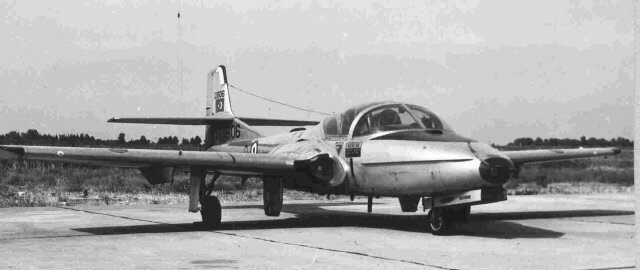 |
| T-37C trainers of 122.Filo were deployed to be used as FAC aircraft. (THK via author) |
 |
| One of F-5A daylight-interceptors from 152.Filo seen while dispersed to Yenisehir. (THK via author) |
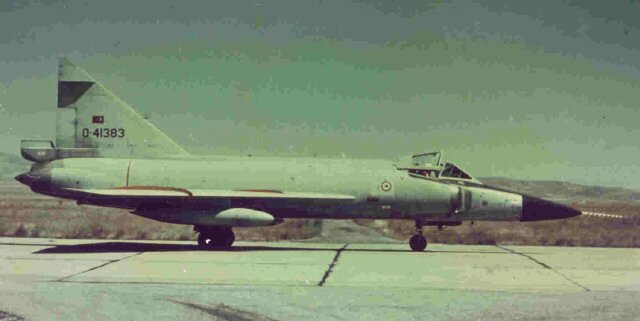 |
| An F-102A photographed at Mürted on July 20th 1974, just a day before the begin of the Turkish invasion. (J. van der Wei, via author) |
After hectic, but futile negotiations, where Britain failed to assert for a return to a normal situation on Cyprus, war operations were started by Turkey on July 20th, in order to protect the Turkish population. The actual war operations, which followed plans already prepared in 1960 when the Turkish population on Cyprus was threatened, were implemented in two stages. The first from July 20th until 1700 hours on the 22nd when the northern outskirts of Nicosia were taken, and with only defensive and transport air operations performed on the 23rd. The second stage which lasted from August 14th until an armistice was affected at 1900 hours on the 16th, resulted in the Turkish Army seizing Farmagusta.
July 20, 1974
On July 20th at 0449 hours a RF-84F reconnaissance aircraft was launched from the Inçirlik Air Base as the first action.
 |
| RF-84Fs of 184.Filo were the first THK aircraft to see action on the morning of 21 July 1974. (THK via author) |
The assault on the island itself was planned for 0600 on the 20th, with an airborne assault at Gönyeli (10 km NW of Nicosia) by 19 C-47s and at Kirni by six C-130s and eleven C-160Ds. All went well, but three aircraft were hit by anti-aircraft fire. A C-130 and a C-160 only sustained light damage, whereas C-47 no.6035 caught fire and only barely made an emergency landing near Silifke on the Turkish mainland.
 |
| THK F-100-pilots being briefed for the operation... |
 |
| ...then leaving for their aircraft.... |
 |
| ...and finally boarding their fully-armed aircraft. (all three THK via author) |
 |
| F-100Ds of 172.Filo at Malatya being readied for their attack missions. (THK via author) |
Meanwhile commando soldiers and Navy Seals secured the coastal road and initiated the seaborne landing at Karaoğlanoğlu 6 miles west of Kyrenia (Girne). A large force of 72 transport helicopters of various types of UH-1s from all Turkish forces had been put under command of the 2nd Armys helicopter Regiment. This force assembled at a temporary operating area near Tasuçu, at the southern most point at the mainland Turkey. From here a combined assault into the areas taken by the airborne troops started at 0707 hours. Ten helicopters were damaged by ground fire as they approached in the perfect V- formation. Later in the day tactics were changed into sudden low level approaches and only two more helicopters received hits.
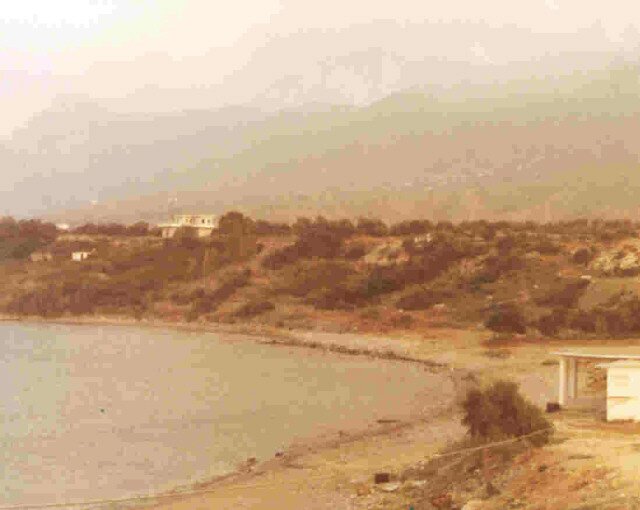 |
| The beach at Karaoğlanoğlu, some six miles west of Kyrenia/Girne, where the Turkish landings took place. (Author) |
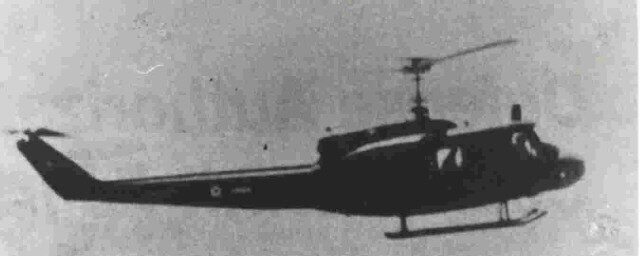 |
| 72 UH-1 helicopters of various marks participated in the first two days of assaults on Cyprus. Twelve were damaged by ground-fire. This is one of 42 UH-1Hs delivered to the Turkish Army between 1970 and 74, seen while coming in for the assault landing. (Turkish Army, via author) |
 |
| UH-1H used in the casualty evacuation role. The Turkish Army also used armed AB.204Bs as gunships during the fighting. (Turkish Army, via author) |
After intensive attacks from the air a second wave of airborne drops was affected by one C-47, 12 C-160s and six C-130s at 1255 and a third wave consisting of six C-160s and three C-130s just before sunset. These last two waves did not take any anti-aircraft fire. Air operations terminated at 2115 hours on the first day after 6000 troops had been put ashore and a bridgehead secured.
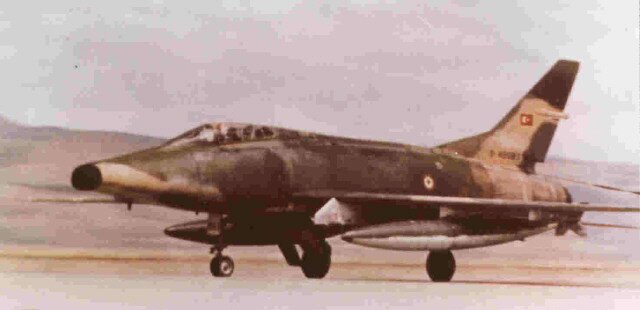 |
| F-100C "54-2083" of 112. Filo was lost on the second day and the pilot had to eject near Sivrihisar. (THK via author) |
The first day of operations included 117 ground attacks, 64 airborne assaults, 18 reconnaissance missions and eight air defence sorties. Air Force losses were one F-100D (55-3756) of 171.Filo, one F-100C (54-2042) of 132.Filo, one RF-84F of 184.Filo and the one C-47 (6035) making a crash landing. The only Air Force aircrew fatality was 1.Lt. Ilker Karter of the 184. Filo, the pilot of the RF-84F. Twelve Army helicopters received light damage and a Do.28D on a clandestine mission crashed with all its occupants being killed.
July 21, 1974
Renewed operations were launched at 0550 hours to attack reported Cyprus troops massing for attack. Included in the attack were Super Sabres from 131, 132, 171 and 172.Filos. 184. Filo provided reconnaissance support. A large convoy of 40 vehicles was spotted on the road winding from Paphos to Nicosia and it was vigorously attacked and destroyed at 0755. The effect of this event was that many Cyprus troops gave up their arms as soon as an aircraft was heard approaching. The battles that day resulted in the Turkish army taking Kyrenia (Girne) but at the high cost of 21 fatalities.
 |
| S-2E trackers of the Turkish Navy deployed to Antalya for sea reconnaissance. (Turkish Navy, via author) |
Meanwhile on the evening of the 20th, reports had been circulating of a Greek ship convoy having been spotted west of the Paphos harbour, on its way from Rhodes. This serious event caused a special alert for the radar units, and S-2Es from the 301. Filo from Antalya were sent to investigate. The radar reports indicated Greek naval manoeuvrering and later reports spoke of 4 destroyers and 7 transport ships. On the 21st, early in the morning, a RF-84F of 184. Filo piloted by the Filo commander, Lt. Col. Yetkiner, made a thorough investigation. His report was frank: "I have seen nothing!" At the same time, however the Radar station at Anamur and a radar sweep by the S-2Es reported several targets. The question was, is it the US 6th fleet or something else? As the morning became day attacks were planned on the "convoy" and the Turkish Navy confirmed that it had no ships in that sector. At 1300 the Air Force gave the target clear for attack, ordering the 111. Filo with F-100Ds and 141. Filo with F-104Gs to get ready to attack at 1335. Later the 181.Filo was also alerted. At 1400 the departures got under way with 111. Filo launching 16 F-100Ds at Eskisehir between 1410 and 1416 and 181. Filo launching 12 F-100Ds from Antalya between 1430 and 1503. Each of the 28 aircraft carried two 750 pound bombs.
 |
| F-100D being bombed up for the mistaken and ill-fated attack on the Turkish destroyer Kocatepe with M-117 750 pound bombs. (THK via author) |
Sixteen F-104Gs of 141.Filo each carrying a 750 pound bomb departed from Ankara/Mürted in the time from 1443 to 1451. In addition two more Filos, 112. Filo with F-100Cs and 191. Filo with F-104Gs were put on ready alert. Before more could be done, however a message was received at 1530 that the aircraft had attacked and sunk a Turkish ship. Later F-104Gs of 191. Filo made a thorough reconnaissance of the area north and west of Cyprus only reporting 4 small vessels. At 2010 air operations for the day were called off with a total of 203 attack and 19 reconnaissance missions,
28 air defence and 23 transport sorties flown (not including army helicopter operations). The day however had seen the loss of four F-100s (a D 55-2825 of 111.Filo and a C.54-2083 of 112.Filo being two of them) and an F-104G (64-17783 of 191.Filo), fortunately without casualties.
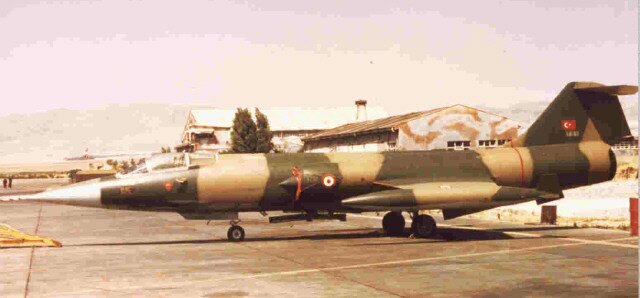 |
| F-104G "64-17783" of the 191.Filo seen at Mürted on 20.July 1974, a day before it crashed. (J. van der Wei, via author |
July 22, 1974
At 0506 in the early morning of the 22nd it was confirmed that the Turkish destroyer "Koçatepe" had been sunk. Three hours later four C-130s dropped medical provisions to the rescue forces in the waters north of Cyprus.
 |
| The seven C-130Es available to the THK in 1974 provided excellent service during the short campaign. (THK via author) |
Meanwhile at 1115 hours in the land battle, 15 C-47s dropped 300 paratroopers in an attack on the area south of Gönyeli, 5 km north of Nicosia. At 1435 17 F-104Gs of 141.Filo attacked the Nicosia airport with 750 pound bombs. This caused the fighting there to stop. At 1535 the Turkish General Command announced an armistice from 1700 onwards. The day had seen 122 attack and 12 reconnaissance missions, 23 air defence and 19 transport sorties completed. An F-5A belonging to the Greek Air Force was seen crashing after an attempt to engage an F-102A (55-3401) flown by Capt. Onur from 142.Filo in an air battle. (some Turkish sources claim that the F-5 was shot down by a Falcon missile)
The days losses were one pilot ejecting from an F-100D (54-2238 of 172.F) and two aircraft destroyed in landing accidents, an F-102A (55-3413) and an F-100C. All three pilots survived.
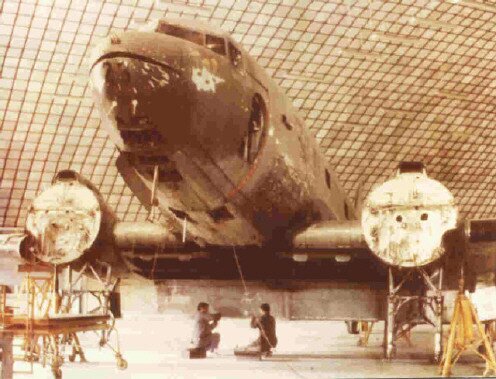 |
| C-47A 6023 with campaign markings on the nose seen during subsequent maintenance. (THK via author) |
 |
| F-102A "55-3401", which was claimed to have downed a Greek F-5A on the 22nd July 1974, is seen with campaign markings. (THK via author) |
July 23, 1974
Having declared an armistice on the 22nd, only 3 reconnaissance missions and 46 air defence sorties were flown on the 23rd. This in response to the incident with the F-5 the day before and because of heavy radar traffic was tracked at the Turkish Air Defence installations. This, however could have been an indication of electronic counter measures. During these operations an F-102A (54-1403) from 142.Filo crashed during take-off, killing the pilot, 1.Lt. Çinar.
 |
| Captured Cypriot National Guard armoured cars... |
 |
| ...and T-34 tanks displayed at Karaoğlanoğlu. (Author) |
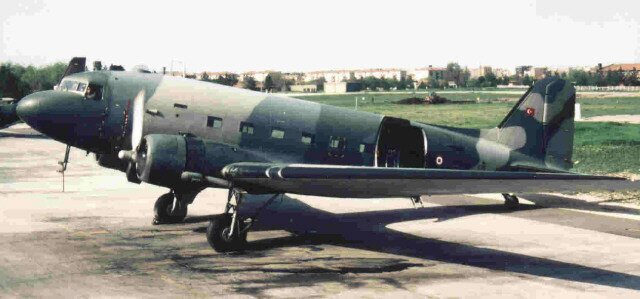 |
| C-47A 6035 was hit by groundfire during the invasion in 1974, but the pilot managed to land it safely. It is seen here still in service 20 years later, shortly before retirement. (MAP via author) |
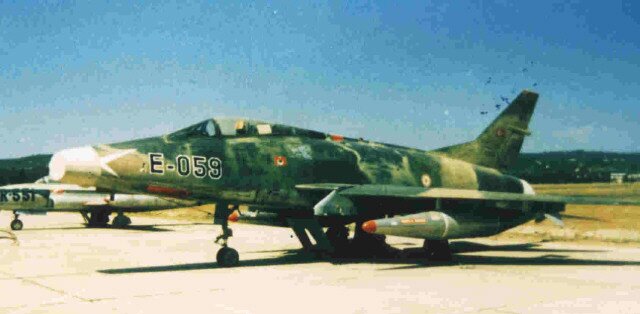 |
| F-100C "54-2059" proudly displaying its campaign markings even while used for technical instruction, in 1996. (THK via author) |
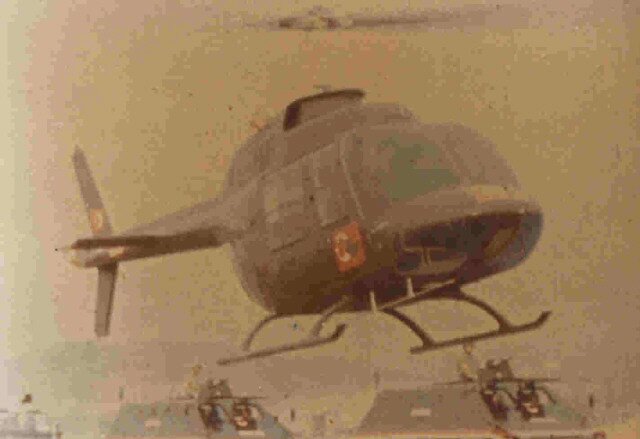 |
| AB.206A of the Jandarma showing its campaign marking during the yearly victory parade at Lefkosa/Nicosia in 1976. (Turkish Jandarma via author) |
Turkish Air Force AOB 1. July 1974
Air Force HQ: Ankara
Air Transport Command (Etimesgut/Ankara)
12. Air Transport Base (Etimesgut/Ankara)
- 223. Transport Filo: C-47A (based in Etimesgut/Ankara)
- 224. Transport Filo: C-47A (based in Etimesgut/Ankara)
- 221. Transport Filo: C-160A (based in Erkilet)
- 222. Transport Filo: C-130E, C-47A (based in Erkilet)
1. Tactical Air Force (Eskisehir)
- 114. Tactical Recce Filo: RF-84F
1. Jet Air Base (Eskisehir)
- 111. Fighter-Bomber Filo: F-100C/D
- 112. Fighter-Bomber Filo: F-100C/D
4. Jet Air Base (Mürted/Ankara)
- 141. All-Weather Fighter Filo: F-104G
- 142. All-Weather Filo: F-102A
- 182. All-Weather Filo: F-102A
6. Jet Air Base (Bandirma)
- 161. Fighter-Bomber Filo: F-5A
- 162. Fighter-bomber Filo: F-5A
- 301. Maritime Filo: S-2E
Air Training Command (Izmir)
2nd Jet Training Air Base (Çiğli)
- 121. Training Filo: T-33A
- 122. Training Filo: T-37C
- 123. Training Filo: T-41D
3. Jet Air Base (Konya)
- 131. Tactical Training Fighter-Bomber Filo: F-100C/D
- 132. Tactical Training Fighter-Bomber Filo: F-100C/D
3. Tactical Air Force (Diyarbakir)
- 184. Tactical Recce Filo: RF-84F
5. Jet Air Base (Merzifon)
- 151. Fighter-Bomber/All-Weather Filo: F-5A
- 152. Fighter-Bomber/All-Weather Filo: F-5A
7. Jet Air Base (Erhac)
- 171. Fighter-Bomber Filo: F-100C/D
- 172. Fighter-Bomber Filo: F-100C/D
8. Jet Air Base (Diyarbakir)
- 181. Fighter-Bomber Filo: F-100C/D
 |
© Copyright 2002-3 by ACIG.org
Top of Page
|
|
 |
Latest Europe & Cold War Database
|
|
Kleine Brogel - Spotter's Day 2005
|
|
Austrian National Day Parade, 26 October 2005
|
|
Pharewell to 337's Phantoms...
|
|
"Archangel '05" Airshow, Tanagra, Greece. Part 2
|
|
"Archangel '05" Airshow, Tanagra, Greece. Part 1
|
|
KLu Open Day: Gilze Rijen, 2005
|
|
TLP 2005-4 Gallery
|
|
Nepolisy Provisional - Czech Radar Station
|
|
Base Visit of the German Air Force JBG-31
|
|
Why Austria Selected Eurofighter EF-2000 Typhoon?
|
|
KLu Open Day: Volkel, 2004
|
|
341 Squadron Hellenic Air Force participation in TLP 2004-2
|
|
Hellenic Air Force Open Day 2003 at Tanagra Air Base, Part 3
|
|
Hellenic Air Force Open Day 2003 at Tanagra Air Base, Part 2
|
|
Hellenic Air Force Open Day 2003 at Souda Air Base, Crete, Part 1
|
|
Spotters-Day Rheine 2003
|
|
Macedonia, 2001
|
|
Austrian Radar Plots
|
|
Yugoslav & Serbian MiG-29s
|
|
MiGs Over Croatia
|
|
Romania, 1989
|
|
European Air-to-Air Victories
|
|
U.S. Air-to-Air Victories during the Cold War, Wars in Yugoslavia, and Anti-Terror War
|
|
Greek & Turkish Air-to-Air Victories
|
|
Cyprus 1974: Greek Point of View
|
|
Cyprus, 1974: Turkish Point of View
|
|
Cyprus, 1974
|
|
Cyprus, 1955-1973
|
|
The Greek Civil War, 1944-1949
|
|
A Cold War Defection
|

|